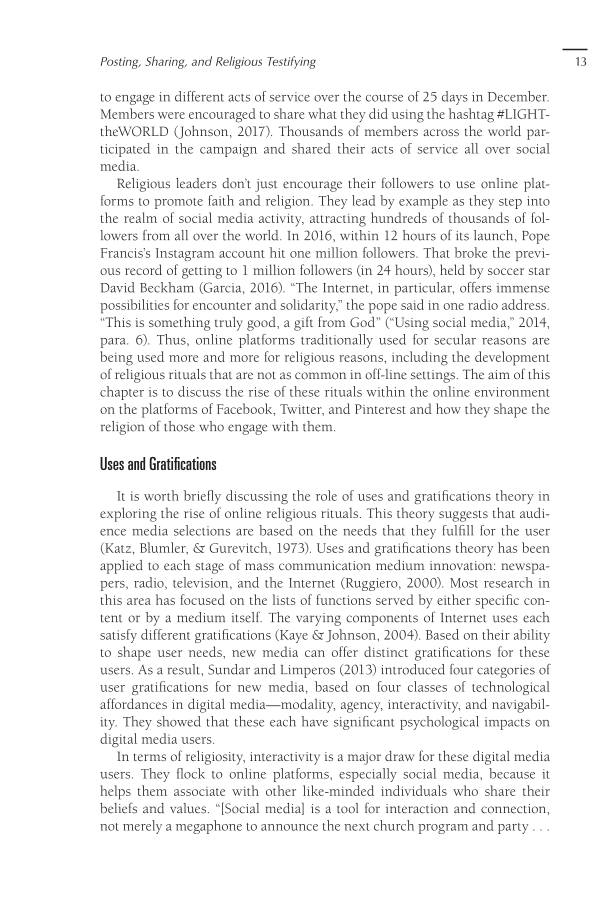Posting, Sharing, and Religious Testifying 13 to engage in different acts of service over the course of 25 days in December. Members were encouraged to share what they did using the hashtag #LIGHT- theWORLD (Johnson, 2017). Thousands of members across the world par- ticipated in the campaign and shared their acts of service all over social media. Religious leaders don’t just encourage their followers to use online plat- forms to promote faith and religion. They lead by example as they step into the realm of social media activity, attracting hundreds of thousands of fol- lowers from all over the world. In 2016, within 12 hours of its launch, Pope Francis’s Instagram account hit one million followers. That broke the previ- ous record of getting to 1 million followers (in 24 hours), held by soccer star David Beckham (Garcia, 2016). “The Internet, in particular, offers immense possibilities for encounter and solidarity,” the pope said in one radio address. “This is something truly good, a gift from God” (“Using social media,” 2014, para. 6). Thus, online platforms traditionally used for secular reasons are being used more and more for religious reasons, including the development of religious rituals that are not as common in off-line settings. The aim of this chapter is to discuss the rise of these rituals within the online environment on the platforms of Facebook, Twitter, and Pinterest and how they shape the religion of those who engage with them. Uses and Gratifications It is worth briefly discussing the role of uses and gratifications theory in exploring the rise of online religious rituals. This theory suggests that audi- ence media selections are based on the needs that they fulfill for the user (Katz, Blumler, & Gurevitch, 1973). Uses and gratifications theory has been applied to each stage of mass communication medium innovation: newspa- pers, radio, television, and the Internet (Ruggiero, 2000). Most research in this area has focused on the lists of functions served by either specific con- tent or by a medium itself. The varying components of Internet uses each satisfy different gratifications (Kaye & Johnson, 2004). Based on their ability to shape user needs, new media can offer distinct gratifications for these users. As a result, Sundar and Limperos (2013) introduced four categories of user gratifications for new media, based on four classes of technological affordances in digital media—modality, agency, interactivity, and navigabil- ity. They showed that these each have significant psychological impacts on digital media users. In terms of religiosity, interactivity is a major draw for these digital media users. They flock to online platforms, especially social media, because it helps them associate with other like-minded individuals who share their beliefs and values. “[Social media] is a tool for interaction and connection, not merely a megaphone to announce the next church program and party . . .
Document Details My Account Print multiple pages
Print
You have printed 0 times in the last 24 hours.
Your print count will reset on at .
You may print 0 more time(s) before then.
You may print a maximum of 0 pages at a time.













































































































































































































































































































































































































































































































































































































































